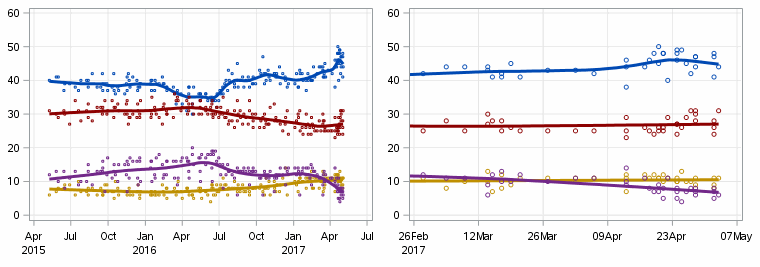An overview and thread for discussion of looming national elections in the United Kingdom and France.
UPDATE: Exit polls from France will be published 4am EST (i.e. early Monday morning), and the actual result should be clear about three hours after that, unless it’s particularly close.
There’s a lot of big election news going down right now at the other side of the globe, starting with the first round of France’s presidential elections on Sunday, to be followed a fortnight later by a run-off between the two leading candidates.
Recent polling indicates the two leading candidates are Marine Le Pen of the far right National Front and Emmanuel Macron, a former Socialist running under his own banner. However, polling hasn’t had a great record in Europe lately, and Nate Silver of FiveThirtyEight has pointed to a suspiciously narrow range of recent French presidential results, which has been known to signify that pollsters are “herding” each other off the end of a cliff. This leaves at least some hope for François Fillon of the centre-right Republicans, whose initially promising campaign has been hobbled by personal scandals. A hard left candidate, Jean-Luc Mélenchon, has gained a head of steam over the past month, although his recorded support has recently tapered off at a level below where he needs to be. Head-to-head polling suggests Le Pen would be heavily defeated in the run-off, particularly if facing Macron.
It also emerged on Tuesday that Britain will go to the polls on June 8, for an election that looms as an historic disaster for Labour. The Conservatives’ unexpected majority victory at the May 2015 election was achieved from 36.9% of the national vote, which netted them 330 seats out of 650, compared with 30.4% and 232 seats for Labour. Recent polling has mostly had it in the low forties, but two polls conducted in the immediate wake of the election announcement had them at 46% (an ICM poll for the Guardian) and 48% (YouGov for The Times). Labour’s recent poll ratings have been anywhere between 23% and 29%, with the most recent results being 24% from YouGov and 26% from ICM. This suggests the Conservatives are in a position to match Labour’s historic landslides under Tony Blair, who won 418 seats in 1997 and 413 in 2001.
Both major parties were up slightly on the primary vote in 2015, but the Conservatives emerged the principal beneficiary of the collapse of the Liberal Democrats. By contrast, Labour was devastated north of the border by the triumph of the Scottish National Party, which won all but three of Scotland’s 59 seats, gaining 40 from Labour and 10 from the Liberal Democrats. The seats remaining to Labour are concentrated in London; Merseyside and Manchester; Leeds and its industrial surrounds; Birmingham; Newcastle and Durham; and south Wales. The rest of England’s electoral map is a sea of blue, punctuated by occasional small islands of red, and still more occasional ones of orange (traditionally associated with the Liberal Democrats).
Each of Labour’s stronghold regions consists of a safe core and a less safe periphery, and it’s the latter areas that are looming as the main battlegrounds of a losing election. To isolate one example, Labour holds 45 seats in the area of Greater London, compared with 27 for the Conservatives and one for the Liberal Democrats. It will continue to dominate the city’s inner east even under worst case scenarios, but will come under pressure in as many as ten seats in the west and on the fringe of the Greater London region.
The polls have generally had the Liberal Democrats at around 11%, representing a modest recovery from the disaster of 2015, when they dropped from 57 seats and 23.1% of the vote to eight seats and 7.9%.
However, opportunities for further gains are limited, and the Conservative tide could even cause the party trouble in the few seats it continues to hold. Ukip yielded only the seat of Clacton from its 12.6% share of the national vote in 2015, and lost that a month ago when Douglas Carswell, a former Conservative MP, quit to sit as an independent. Polls suggest the party has shed support to the Conservatives, so its pickings in the House of Commons look likely to remain slim or non-existent.
The polls I’ve looked at for Scotland suggest the Scottish National Party will retain most if not all of its 50.0% support from 2015, so the party will presumably continue to dominate Scotland’s 59 seats, of which it holds all but three. Any talk of a defeat for the government is being framed in terms of its majority being lost to a “progressive alliance” of Labour, the Scottish National Party and the Liberal Democrats, but at this stage it seems very unlikely it will come to that.
